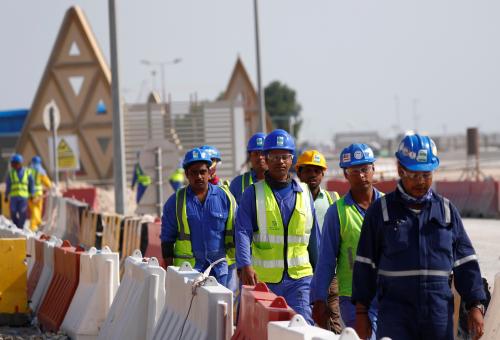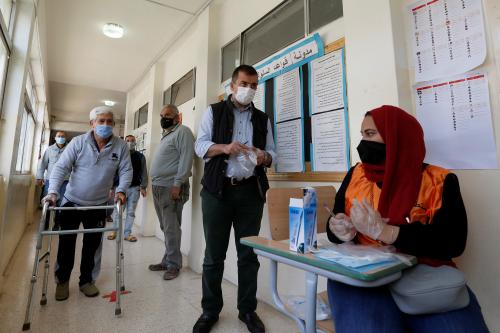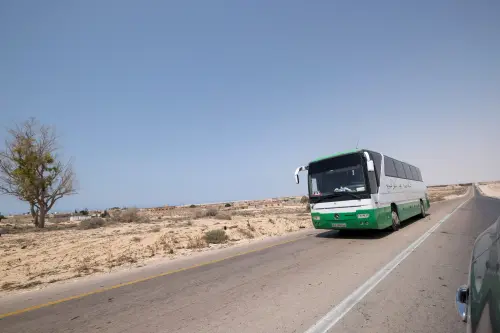Content from the Brookings Doha Center is now archived. In September 2021, after 14 years of impactful partnership, Brookings and the Brookings Doha Center announced that they were ending their affiliation. The Brookings Doha Center is now the Middle East Council on Global Affairs, a separate public policy institution based in Qatar.
A severe and structural “triple crisis” (socio-economic, political, and ecological) is facing the Islamic Republic of Iran four decades after its inception and has triggered massive nationwide protests over the last two and a half years. Now, in the midst of the coronavirus pandemic, the country is facing a new set of crises: a dual public health and economic crisis, compounded by an oil price crisis. Iran’s worsening economic and socio-economic conditions, coupled with sustained public disillusionment regarding the regime’s ability to meaningfully address them, could pave the way for renewed street mobilizations against the regime once the pandemic subsides.
Questionable priorities
Amid controversy over the length and severity of lockdown measures, President Hassan Rouhani and top officials have won a dubious victory over health experts, the health ministry, and local authorities. The former camp has argued that the economic costs of continuing the lockdown are likely to be greater than the health costs of lifting it — in other words, they have argued for saving the economy, rather than lives. The overriding concern of these top officials has been the prospect of an economic meltdown due to the effects of continued U.S. sanctions, the oil price collapse, and COVID-19.
The latter camp has warned that, in the absence of restrictions, the public health crisis will be sustained, only to be accompanied by an economic crisis. The prediction of a dual health and economic crisis appears to have been proven right; as Iranian authorities shied away from strict lockdown and quarantine measures, a second wave of virus infections hit the country in May.
Meanwhile, the oil price crisis is here to stay. After a series of emergency meetings, OPEC+ agreed on April 12 to a record oil reduction deal, reducing global output by 10 percent in May and June, with lesser reductions continuing until April 2022. Heavily affected by the pandemic global oil demand has dropped to a 25-year low. While there are now hopes that consumption will reach pre-crisis levels by 2022, it is doubtful whether or when the oil price will be high enough to meet Iran’s budgetary plans. Iran still faces challenges as an oil exporter in an ever-changing global market, amid rivals who do not shy away from weaponizing the issue to place pressure on the country.
Economic toll
According to the deputy head of Iran’s Chamber of Commerce, every single day of business closures costs the country an estimated $164 million. The service sector, which generates around half of Iran’s gross domestic product (GDP), has been heavily affected by the pandemic, with the flow of services disrupted and small businesses facing bankruptcy. Moreover, Iran’s regional exports — seen as the backbone of its economy under U.S.-led sanctions — have been massively hit, with borders closing and flights halted. The tourism sector — with the Chinese constituting a key market — has also been undermined, leading to job losses. In other words, Iran’s already ailing economy has faced heavy blows due to both the dramatic decline of oil prices and the effects of the pandemic.
In April, the International Monetary Fund (IMF) stated that the coronavirus crisis would drive the global economy into its most severe recession since the Great Depression, with a 3 percent contraction projected this year. It also predicted that the Middle East and North Africa (MENA) region would be disproportionately hit, with Iran’s economy to experience a 6 percent contraction. It should be noted that these figures are premised on Iran exporting 500,000 barrels per day (bpd) of oil, but that the country is believed to have sold only 144,000 bpd in March.
The IMF also expects Iran’s net debt to soar, reaching around one-third of its 2020 GDP (or $148 billion), a sharp rise of 22.5 percent compared to last year. Iran’s foreign debt, meanwhile, is believed to stand at 2.7 percent of GDP (or $11.9 billion, compared to $10.8 billion last year). Crucially, Iran’s non-oil sector (which is key for job creation) is expected to decline much more severely than in the past — 6 percent this year, compared to 1.2 percent last year. Total exports are expected to fall to $46 billion this year, a loss of one-fifth compared to last year; in comparison, Iran’s 2017 exports totaled $110 billion. Imports are expected to rise to $64.6 billion, resulting in Iran’s imports far exceeding its exports — a novelty for the country. Furthermore, Iran’s gross official reserves are expected to lose almost one-fifth of their value compared to last year, falling to $85.2 billion in 2020 and to $69.1 billion in 2021. Iran’s rapidly deteriorating economic conditions will likely aggravate political tensions.
Socio-economic toll
In early April, a poll in Tehran reportedly found that 70 percent of residents were in financial distress trying to provide for their families, or had savings that would run out within two months of unemployment. Nearly half of those polled said they did not trust official COVID-19 statistics. There was reason for them to be skeptical — according to an April report by the Majlis Research Center, the parliament’s research arm, the true virus death toll in Iran was probably 80 percent higher than official figures, while the infection number may have been eight to 10 times higher.
As in other countries, Iran’s class divide has structured people’s response to the virus and government measures. While some individuals self-quarantine in Tehran’s affluent north, others continue to ride overcrowded public transport to work in the capital’s poor south. On April 11, the deputy health minister said that one-fourth of those infected with the virus had contracted it on public transport, including buses and the metro.
Notably, the prices of property and gold (key investments) continue to rise, and the value of currency continues to fall. Iran’s Ministry of Roads and Urban Development announced in May that the average purchasing price for a square meter of living space in Tehran had reached 17 million toman (around €900), having risen by nearly €80 in four weeks, while the price of gold increased by over 14 percent between April 17 and May 17. Speculation and hit-and-run property investments have significantly contributed in the past to steadily rising rent and property prices, especially in Tehran. At the same time, the national currency continues to lose value, standing at about 18,800 toman to the euro in May, compared to 15,000 toman in March.
Warnings of protests and riots
In early April, the Majlis Research Center warned that “protests” and “riots” could break out because of the economic impact of COVID-19. On April 11, Rouhani administration spokesman Ali Rabiei wrote that the coronavirus outbreak had negatively affected 3.3 million full-time employees and 4 million self-employed workers, with 7 million Iranians having either lost employment or been temporarily suspended or downgraded. Previously, Rouhani had been reported as saying that 30 million Iranians had experienced economic losses, which his spokesman later denied. Establishment figures from across the political spectrum have sounded the alarm bells, predicting “riots bigger than 2017 and 2019” and a more intense “cycle of violence.”
According to IHS Markit, the combination of existing grievances and conflicts with those that have been newly triggered by the pandemic means that in the short term (the period when the virus is spreading) there is “a low risk of protests and riots in urban areas across the MENA region” and especially in Iran. The company notes that, in the long term (after the spread has peaked), Iran is among “the most vulnerable countries for destabilizing unrest.” Indeed, the overlap of existing and emerging crises is likely to revitalize popular protests. The deterioration of economic and socio-economic conditions and the regime’s misled response to the pandemic have further alienated a disenchanted population, making clear that the system has little to offer with respect to Iranians’ multifaceted grievances.



Commentary
Op-edEmerging pandemic-related triple crisis raises fears of protests in Iran
June 21, 2020